


|
The French Powder Mystery is a spell-binding tale of crime, intrigue, and extraordinary detection. At crowded noon, in front of Fifth Avenue's most fashionable department store, while hundreds of sidewalk onlookers watch a demonstration of modernistic furniture in the window, the demonstrator touches a button regulating a concealed wall-bed--the bed swings out of the wall--and from its dark recesses tumbles the distorted, crumpled corpse of a beautiful woman.... Ellery Queen moves vitally and refreshingly through his own story -- a slender, cynical young man with a genius for piercing the veil of commonplaces and arriving at foolproof conclusions. Old Inspector Queen, his father, again takes you through the complicated process of a police investigation, although it is Ellery who is responsible for the solution of one of the most stimulating and baffling detective stories ever written. And the denouement is surprising and yet inevitable. |
|
"A brilliant, thrilling, ingenious story."
--
William
Lyon Phelps "The logical successor to Sherlock Holmes." -- London Times "Ellery Queen belongs with Sherlock Holmes, Arsene Lupin, Philo Vance, and other master-minds. -- William Lyon Phelps "This is not a book that you pick up; it is a book that you don't put down!" -- Elizabeth Bibesco Week-End Review |
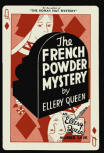 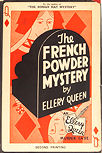 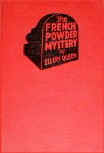 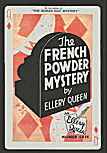  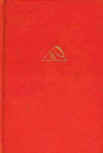  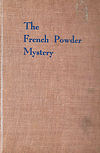 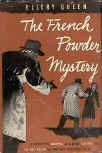 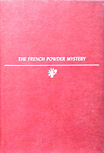 |
| Above: The first books published sometimes had identical front covers. The spine of the books/dust cover only differ in the publisher's logo. Top left to bottom right: 2 dust covers (for the first and second edition) with identical hardcover for Stokes (7 printings); soft and hardcover for the Grosset & Dunlap edition (16 printings); International Readers League (hardcover only), dust and hardcover Triangle Books; dust and hardcover for the Tower/ World Publishing edition. (Click on the covers to see the differences) * |
| The Sunday Star, Washington
D.C. "Reviews of the New Books" by Ida Gilbert Myers. - August 10. 1930 "Suppose, at noon today, we are standing before the display window of a big department store on F street. And suppose, at the instant, a door in the back wall of that window room opens on its own account apparently, and there falls to the flood a woman—dead; upon investigation, murdered. No such bizarre thing would happen, could happen. But such is the starting point of Ellery Queen’s new mystery tale. The mystery of the department store. It must be granted that an establishment of this type does offer quite a field for action and concealment — but, nonsense! Sheer nonsense! From this startling moment forward, however, this ceases to be even the semblance of a romance, mystery or otherwise. It becomes arithmetic. Two plus two are four. But, you see, the world so often gets the answer “five” or “six” or any other old number for this simple partnership of two plus two that strict adherence to two numbers in their exact summation is quite out of the question. This long story goes into the innumerable erroneous combinations that serve to mystify both the authorities and the plain population with as many false clues as this combination is forced to yield through the unlogic of the mind of man. One forgets the matter at times, forgets that he is hunting for a criminal, in his zeal to follow this wizard of exact analysis. Exciting and rather self-inflating for the reader to begin to look upon himself as a mystical mathematician, in embryo at least. Not the brightest scholar imaginable, I, for when well along, I was asked to apply my logic (?) and thereby to point to the guilty man. I was lost. Ashamed, but lost nevertheless. And let me tell you something. I have a grievance right here. Have had it in respect to one or two other mystery tales. When the criminal was found he was so much of a surprise that I immediately accused that author of hiding him purposely. Do you suppose he would do that? Particularly this Ellery Queen, who boldly advertises “a problem in deduction.” Do you think he would? No? Well, then I’m clear past hope. I’d tremendously like to go over that ground again — but “the bird of time has but a little way to flutter, and the bird is on the wing.” And there are 49 other mystery stories right here beside me. I’d like to do it, though." |
|
Ellery Queen’s second novel, The French Powder Mystery (1930), opens with an unforgettable scene of pure mystery and shock. In the display window of a high-end New York department store, a hidden door suddenly swings open, revealing the lifeless body of a woman. The crowd gathered outside is horrified, and the police quickly arrive to investigate. What appears to be an inexplicable crime soon unravels into a complex and carefully constructed puzzle, as Ellery Queen and his father, Inspector Richard Queen, delve into a case that showcases the author's remarkable skill in detective fiction. The unusual crime scene—a department store, a setting rife with hidden corners, backrooms, and extensive employee networks—offers an ideal stage for intrigue and deception. The investigation soon reveals that the victim is Mrs. French, wife of the store’s owner. As the Queens examine the crime, they are drawn into a web of false alibis, hidden motives, and meticulously placed clues. The challenge for Ellery is not just to identify the murderer but to methodically eliminate false trails in pursuit of an unshakable truth. The novel’s structure is a testament to the logical rigor that defines Ellery Queen’s best work. Michael E. Grost notes that the first two-thirds of the book are devoted to an exhaustive investigation, spanning twenty-five chapters. This extended buildup allows for a gradual deepening of the mystery, as each phase of deduction brings new complications. Clues related to keys, time schedules, and restricted access play crucial roles in constructing a labyrinthine plot. The attention to detail in tracking the movement of characters and objects within the store contributes to an intricate, almost geometric puzzle. Queen's fascination with spatial and temporal boundaries—who knew what and when, who entered and exited at precise moments—adds another layer of intellectual challenge for the reader. |
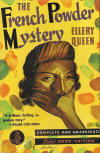   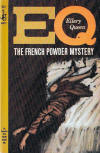     |
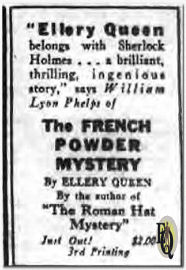 Contemporary critics were quick to recognize the
novel’s brilliance. A particularly insightful review from The Sunday
Star (Washington, D.C.), written by Ida Gilbert Myers on August 10.
1930, offers a vivid impression of the novel’s impact. Myers marvels at the
transformation of the mystery into a nearly mathematical exercise, where
logic reigns supreme. “This ceases to be even the semblance of a romance,
mystery or otherwise. It becomes arithmetic. Two plus two are four. But, you
see, the world so often gets the answer ‘five’ or ‘six’ or any other old
number… that strict adherence to two numbers in their exact summation is
quite out of the question.” Myers highlights how Queen’s rigorous deductive
process absorbs the reader completely, turning them into participants in the
intellectual challenge. She admits, however, that she was utterly confounded
by the novel’s ultimate revelation: “When the criminal was found he was so
much of a surprise that I immediately accused that author of hiding him
purposely.” Contemporary critics were quick to recognize the
novel’s brilliance. A particularly insightful review from The Sunday
Star (Washington, D.C.), written by Ida Gilbert Myers on August 10.
1930, offers a vivid impression of the novel’s impact. Myers marvels at the
transformation of the mystery into a nearly mathematical exercise, where
logic reigns supreme. “This ceases to be even the semblance of a romance,
mystery or otherwise. It becomes arithmetic. Two plus two are four. But, you
see, the world so often gets the answer ‘five’ or ‘six’ or any other old
number… that strict adherence to two numbers in their exact summation is
quite out of the question.” Myers highlights how Queen’s rigorous deductive
process absorbs the reader completely, turning them into participants in the
intellectual challenge. She admits, however, that she was utterly confounded
by the novel’s ultimate revelation: “When the criminal was found he was so
much of a surprise that I immediately accused that author of hiding him
purposely.” |
|
Above right: Add for
The French Powder Mystery in The New York Evening Post (July 17. 1930) |
| The Clinton Courier, October
22 (?). 1930 "Another detective story by the author of "The Roman Hat Mystery" which had such a run last year. As in the former tale, there is much entangling and intertwining of clues. So many and various are the characters involved that it must be a lynx-eyed and clear-headed reader who is not surprised when, at the last moment, the criminal stands revealed." |
|
Despite the intricate plot and masterful deduction, some critics have pointed out that the novel’s resolution lacks the final, stunning revelation that later Queen books would master. Michael E. Grost observes that the novel “runs out of steam two thirds of the way through,” with its ultimate solution hinging on a single new clue rather than an explosive final twist. However, he acknowledges that Queen compensates for this by delivering “a full mead of deduction and revelation” throughout the book, keeping the reader engaged in the unraveling process. The Clinton Courier (October 22. 1930) similarly noted that the sheer volume of clues and characters required an exceptionally sharp reader to anticipate the ending: “It must be a lynx-eyed and clear-headed reader who is not surprised when, at the last moment, the criminal stands revealed.” Beyond its complex mystery, The French Powder Mystery also captures a unique snapshot of its time. The novel’s setting—a department store furnished in what Queen describes as “modernist” style—is a clear nod to the Art Deco movement, though the term itself is never used in the text. Grost points out that Queen’s vivid descriptions of the store’s furniture and décor provide an accurate reflection of how contemporary audiences viewed the emerging aesthetic. Given the present-day enthusiasm for preserving America’s Art Deco heritage, this aspect of the book adds a layer of historical significance that extends beyond the confines of detective fiction. |
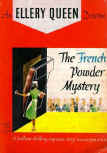 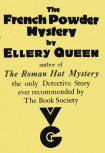 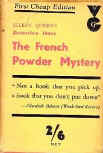 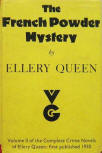 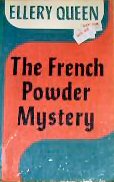 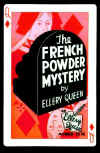  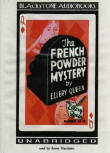  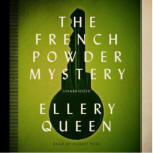 |
|
The novel’s immediate success was a testament to the growing influence of Ellery Queen. It went through seven impressions, three before publication, before being handed over to the reprinters—a remarkable feat that underscores the high demand for the author’s work. Today, first-edition copies with original dust jackets are extremely rare and highly sought after by collectors, often commanding four-figure sums in the rare book market. Ultimately, The French Powder Mystery solidified Ellery Queen’s reputation as a master of the fair-play detective novel. Its precise construction, methodical unraveling of clues, and emphasis on deductive reasoning exemplify the qualities that made Queen a household name in mystery fiction. While later entries in the series would refine and elevate the formula, this early work remains a compelling testament to the genre’s intellectual allure. Its lasting appeal lies not only in the crime itself but in the intricate, almost mathematical process of solving it—a challenge that continues to captivate readers nearly a century after its first publication. |
 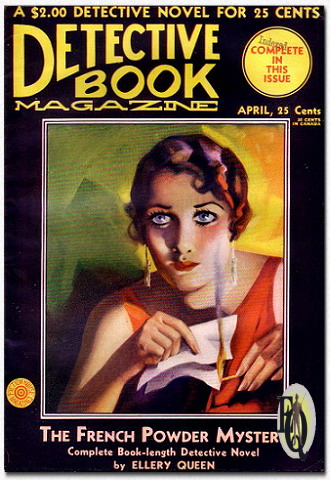 Above left: Not "the" French department store but a very similar store on the corner of Fifth Avenue & 53 Street (1922). The French department store was located on the corner of Fifth Avenue & 39th Street. Above right: Cover April 1931 Publication in Detective Book Magazine. |
|
Elements for "The Game" The story again takes place in N.Y. at the French warehouse on the corner of 39nd street and Fifth Avenue. Winifred March gets murdered with a French colt .38 We get to know Ellery, again with walking stick, a thin silver watch and pince-nez (which isn't exactly the same as a lorgnet), in a much more physical way. He is described as a tall athletic man with the suggestion of force, looked very intelligent around the forehead had long fingers and cool stiff lips. He looked thirty but was actually younger. His clothes came from Bond street. Richard Queen again handles the old brown snuffbox and is involved in the case of Pete Slavin's gang. The "monkeylike" Djuna, Hagstrom (who performs steno!), Hesse, Flint, Ritter, Johnson, Pigott and Velie reappear. As do Dr.Prouty, Henry Sampson (involved in the "White Test Case") and the redheaded Timothy Cronin. Several references to other cases in this book: "The arrest of Don Dickey", an American jewel thief in Berlin for which the mayor gave him a special aluminum tool for research as award. In "the Kingsley Arms murder", O'Shaughnessy had killed Herrin, which was proven by lifting his fingerprints from dead man's shoe. Ellery also got an idea for a short-story by reading something about "The Retreat of the 10000 in the Old Armenia." noticing "...the sandals these men wore during sleep were frozen to the ground." In chapter 22 some of the great adventure (and sometimes mystery) writers of an earlier generation (Doyle, Jack London, Robert W. Chambers, George Barr McCutcheon, Richard Harding Davis) are mentioned. The challenge to the reader is included, as is the map and the list of
characters. |
|
The French Powder
Mystery Translations: |
|
Other articles on this book (1) The Green Capsule Noah Stewart (Jun 2017) (2) Mysteries Ahoy! Aiden Brack (Dec 2017) (3) The Invisible Event JJ (May 2017) (4) Reading Ellery Queen Jon Mathewson (Feb 2013) (5) My Reader's block Bev Hankins (April 2018) (6) Ellerius Bibliophilus Ho-Ling (June 22. 2011) (7) The Grandest Game in the World Nick Fuller (Sep 2. 2021) (8) Clothes in the Books (Mar 22. 2021) (9) Dead Yesterday (Jan 11. 2020) (10) In Search of the Classic Novel Puzzle Doctor (Jun 6. 2011) (11) Mystery Page turners Pauline Dewan (Mar 21 2011) (12) Technical difficulties Sarah Monette (Oct 26. 2010) - spoilers! (13) The French Powder Mystery Stephen M. Pierce (Aug 24. 2024) - spoilers! |
|
*
Interested readers should know
that the icons/covers
of books, used throughout the
website have extra
descriptions/information not
included in the text on the same
page. Pointing your cursor at
the icon/cover used to reveal
this extra information. To achieve the same effect Firefox users can install an add-on called 'Popup ALT Attribute'. When installed pointing your cursor at an icon/cover results in showing you the details or additional information. |
|
Page first published April 18. 1999 Version x2.1 - Last updated March 26. 2025 |

|